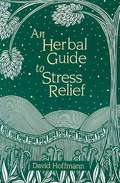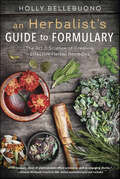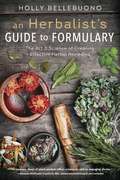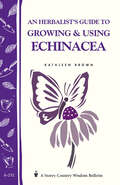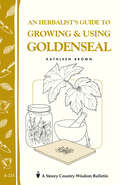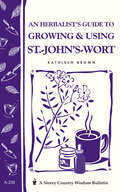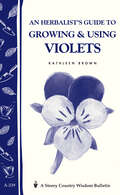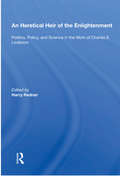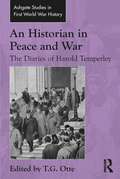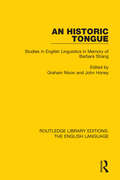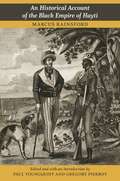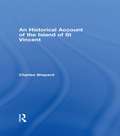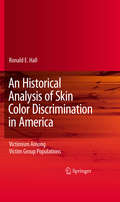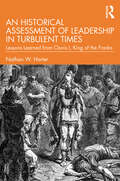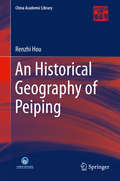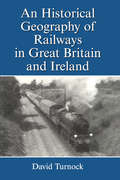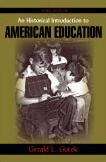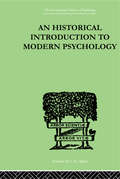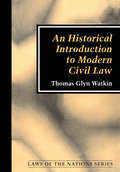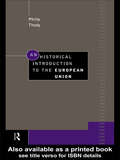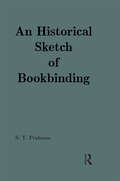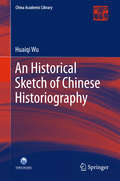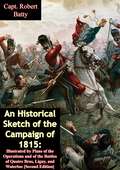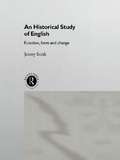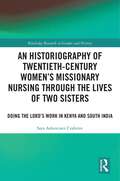- Table View
- List View
An Herbal Guide to Stress Relief: Gentle Remedies and Techniques for Healing and Calming the Nervous System
by David HoffmannDavid Hoffmann, widely respected herbalist and author of Medical Herbalism, looks at stress and anxiety from a holistic perspective and shows how a wide variety of natural treatments can be used in alleviating the physical and mental problems caused by the stress of modern living. He also offers advice on the use of herbs in recovery from chemical dependencies and provides a therapeutic index dealing with stress-related diseases.
An Herbalist's Guide to Formulary: The Art & Science of Creating Effective Herbal Remedies
by Holly BellebuonoExplore the ancient art of formulary with award-winning herbalist Holly Bellebuono's comprehensive guide to creating effective herbal medicine. Organized by body systems, An Herbalist's Guide to Formulary shows how to design a holistic treatment for acute and chronic conditions.Packed with detailed information on more than one hundred plants, An Herbalist's Guide to Formulary is the go-to reference for formulary. Holly presents her 4-tier formula structure, a commonsense way to integrate a wide range of herbal actions while keeping the formula simple. She also shares the history of healing traditions as well as personal and clinical examples that illustrate the art of combining plants for illnesses, preventative care, and overall wellness. With this book's guidance, healing-arts practitioners can turn formulary into a rewarding and practical skill.Praise:"Holly has blended the richness of the Western herbal tradition with the transformative insights of modern holistic medicine. This book is a cornucopia of herbal insights."—David Hoffmann, BS, FNIMH, medical herbalist
An Herbalist's Guide to Formulary: The Art and Science of Creating Effective Herbal Remedies
by Holly BellebuonoExplore the ancient art of formulary with award-winning herbalist Holly Bellebuono's comprehensive guide to creating effective herbal medicine. Organized by body systems, An Herbalist's Guide to Formulary shows how to design a holistic treatment for acute and chronic conditions.
An Herbalist's Guide to Growing & Using Echinacea: A Storey Country Wisdom Bulletin (Storey Country Wisdom Bulletin Ser.)
by Kathleen BrownSince 1973, Storey's Country Wisdom Bulletins have offered practical, hands-on instructions designed to help readers master dozens of country living skills quickly and easily. There are now more than 170 titles in this series, and their remarkable popularity reflects the common desire of country and city dwellers alike to cultivate personal independence in everyday life.
An Herbalist's Guide to Growing & Using Goldenseal: Storey's Country Wisdom Bulletin A-233 (Storey Country Wisdom Bulletin Ser.)
by Kathleen BrownSince 1973, Storey's Country Wisdom Bulletins have offered practical, hands-on instructions designed to help readers master dozens of country living skills quickly and easily. There are now more than 170 titles in this series, and their remarkable popularity reflects the common desire of country and city dwellers alike to cultivate personal independence in everyday life.
An Herbalist's Guide to Growing & Using St.-John's-Wort: Storey Country Wisdom Bulletin A-230 (Storey Country Wisdom Bulletin Ser.)
by Kathleen BrownSince 1973, Storey's Country Wisdom Bulletins have offered practical, hands-on instructions designed to help readers master dozens of country living skills quickly and easily. <P><P>There are now more than 170 titles in this series, and their remarkable popularity reflects the common desire of country and city dwellers alike to cultivate personal independence in everyday life.
An Herbalist's Guide to Growing & Using Violets: Storey Country Wisdom Bulletin A. 239
by Kathleen BrownSince 1973, Storey's Country Wisdom Bulletins have offered practical, hands-on instructions designed to help readers master dozens of country living skills quickly and easily. There are now more than 170 titles in this series, and their remarkable popularity reflects the common desire of country and city dwellers alike to cultivate personal independence in everyday life.
An Heretical Heir Of The Enlightenment: Politics, Policy And Science In The Work Of Charles E. Lindblom
by Harry RednerThis is primarily, but not exclusively, a book on Lindblom. All the pieces in it bear on his work, either as direct commentary on it or criticism of it, or as extensions of his ideas. But at the same time every piece follows the trajectory of its own ideas into the subject matter in which it delves. And these subjects are many and varied. Indeed, the prime purpose of this volume is to make the broad public aware of the full scope and amplitude of Lindblom' s thought and to convey something of the inner coherence that governs it. Anyone who has previously encountered Lindblom only in one manifestation of his multifaceted mind might be surprised to learn that there are so many other facets as well. Merely to list the disciplines to which he has contributed threatens to extend into an academic catalogue of ships. But the truth is that his work is not docilely academic, it refuses to lie down neatly and supinely into the procrustean beds of the established disciplines. Like his closest predecessor, Veblen, he offers a comprehensive treatment of social reality as a whole -- together with something of the same heretical thrust against the academic establishment.
An Historian in Peace and War: The Diaries of Harold Temperley (Routledge Studies in First World War History)
by T. G. OtteThe First World War and subsequent peace settlement shaped the course of the twentieth century, and the profound significance of these events were not lost on Harold Temperley, whose diaries are presented here. An established scholar, and later one of Britain’s foremost modern and diplomatic historians, Temperley enlisted in the army at the outbreak of the war in August 1914. Invalided home from the Dardanelles campaign in 1915, he spent the remainder of the war and its aftermath as a general staff officer in military intelligence. Here he played a significant role in preparing British strategy for the eventual peace conference and in finalising several post-war boundaries in Eastern Europe. Later, in the 1920s and 1930s, Temperley was to co-edit the British diplomatic documents on the origins of the war; and the vicissitudes of modern Great Power politics were to be his principal preoccupation. Beginning in June 1916, the diary presents a more or less daily record of Temperley’s activities and observations throughout the war and subsequent peace negotiations. As a professional historian he appreciated the significance of eyewitness accounts, and if Temperley was not at the very heart of Allied decision-making during those years, he certainly had a ringside seat. Trained to observe accurately, he recorded the concerns and confusions of wartime, conscious always of the historical significance of what he observed. As a result there are few sources that match Temperley’s diary, which presents a fascinating and unique perspective upon the politics and diplomacy of the First World War and its aftermath.
An Historic Tongue: Studies in English Linguistics in Memory of Barbara Strang
by Graham Nixon and John HoneyThis volume, first published in 1988, represents in its papers the wide-ranging yet coherent linguistic interests of the late Barbara Strang (1925-1982). For her, the history of English and its current state were two sides of the same coin, and the principle theme of this collection is that neither one may be properly understood without invoking the other. It is a ‘real-data’ collection, in that its contributors share the view that the facts of language, patiently gathered, recorded and collated, must govern the theory within which they are described, and not vice versa. This philosophy may be seen to operate in all the contributions, and to result in a truly three-dimensional picture of English: data; distribution (temporal, geographical, situational and social); and description. This book will be of interest to students of English language and linguistics.
An Historical Account of the Black Empire of Hayti
by Paul Marcus Rainsford Youngquist Pierrot GrégoryAs the first complete narrative in English of the Haitian Revolution, Marcus Rainsford's An Historical Account of the Black Empire of Hayti was highly influential in establishing nineteenth-century world opinion of this momentous event. This new edition is the first to appear since the original publication in 1805. Rainsford, a career officer in the British army, went to Haiti to recruit black soldiers for the British. By publishing his observations of the prowess of black troops, and recounting his meetings with Toussaint Louverture, Rainsford offered eyewitness testimonial that acknowledged the intelligence and effectiveness of the Haitian rebels. Although not an abolitionist, Rainsford nonetheless was supportive of the independent state of Haiti, which he argued posed no threat to British colonial interests in the West Indies, an extremely unusual stance at the time. Rainsford's account made an immediate impact upon publication; it was widely reviewed, and translated twice in its first year. Paul Youngquist's and Grégory Pierrot's critical introduction to this new edition provides contextual and historical details, as well as new biographical information about Rainsford. Of particular interest is a newly discovered miniature painting of Louverture attributed to Rainsford, which is reproduced along with the twelve engravings that accompanied his original account.
An Historical Account of the Island of St Vincent
by Charles ShepardCharles Shephard, a legal officer of the island of Saint Vincent, made no attempt at objectivity in his account of the great 1795 Carib rebellion, this book being dedicated to the British survivors. But having had access to several contemporary diaries and having interviewed survivors, he was able to correct and expand the narratives of Bryan Edwards and Dr Coke, making this work the most detailed account of the overthrow of a unique people.
An Historical Analysis of Skin Color Discrimination in America: Victimism Among Victim Group Populations
by Ronald E. HallRacism in America is most-commonly studied as white racism against minority groups (racial, gender, cultural). Often overlooked in this area of study is the discrimination that exists within minority groups. Through a detailed historical and sociological analysis, the author breaks down these pernicious, complex, and often misunderstood forms of skin color discrimination: their origins and their manifestations in modern world. Shedding new light on these sensitive issues, this volume will allow them to come to the forefront of academic research and open dialogue. This comprehensive work will include coverage of skin color discrimination within racial, ethnic, sexual, and gender minority groups, and their particular forms and consequences. An Historical Analysis of Skin Color will be an important work for researchers studying the Sociology of Race and Racism, Gender Studies, LGBT Studies, Immigration, or Social Work.
An Historical Assessment of Leadership in Turbulent Times: Lessons Learned from Clovis I, King of the Franks (Leadership: Research And Practice Ser.)
by Nathan W. HarterThis unique book provides lessons on how to affect good leadership in turbulent times by taking a historical lens and examining the life and impact of Clovis I, King of the Franks. Through the exploration of how this individual managed the unstable times where so many others had failed, the book provides an original take on leadership, focusing on the ways we can learn from and be inspired by his history. This book offers an insightful and detailed case study of Clovis I, as it explores his struggles and triumphs in the face of turbulent times. The book presents implications for students of leadership today and examines why the story of Clovis I reveals the salience of leadership during times of uncertainty and change. Ultimately, the author foresees the rise of myriad leaders trying to manage the upheaval in the twenty-first century, with the likelihood that somebody like Clovis I will emerge, pursuing ambition and re-ordering civilization on a colossal scale, leaving a legacy that will endure for a further thousand years. This book will be of interest to leadership and history scholars and advanced students in Leadership studies.
An Historical Geography of Peiping (China Academic Library)
by Renzhi HouThis book is about the city of Peiping in China, also known as Beijing and Peking, and a city of great historical significance. Divided into three parts, this work explores Peiping first as a frontier city at a time when the Great Wall was established, from the Chou dynasty (ca. 1122--220 B. C. ) until the T'ang Dynasties up to the Khitan Occupation (A. D. 590--937). The second part explores Peiping as it becomes a national centre, through the Liao Dynasty and the Chin Dynasty, until 1234, and the third part explores how it became the capital of the Chinese empire, until 1911. This work is a historical geography and the introduction details topographical features and geographical relations of the city, describing the way in which the mountains rise from the plain creating concave arms to enclose Peiping, leading to the name, the 'Bay of Peiping'. We learn that the mountains frequently reach over 3000ft and have practically no foot-hills, whilst the bay itself is filled with sediments of gravel, sand, loam and loess which have been deposited in horizontal strata, to a great depth. Numerous illustrations and figures are included, and readers will see how the city sits between two rivers, the Hun (浑河 or Muddy River) and the Pai (白河 or White River). These chapters reveal how each river has made its contribution to the material development of the city and its environs, including through irrigation and as the Hun River shifted its course. Owing to the geography of the region, almost all roads leading from the northern lands of Mongolia and Manchuria to the great plain of North China in the south are bound to converge at Peiping. The historical consequences of this, as well as local climate conditions and other aspects of geography are explored in this book, which traces the historical rise to eminence of Peiping.
An Historical Geography of Railways in Great Britain and Ireland
by David TurnockAlthough a great deal has been published on the economic, social and engineering history of nineteenth-century railways, the work of historical geographers has been much less conspicuous. This overview by David Turnock goes a long way towards restoring the balance. It details every important aspect of the railway’s influence on spatial distribution of economic and social change, providing a full account of the nineteenth-century geography of the British Isles seen in the context of the railway. The book reviews and explains the shape of the developing railway network, beginning with the pre-steam railways and connections between existing road and water communications and the new rail lines. The author also discusses the impact of the railways on the patterns of industrial, urban and rural change throughout the century. Throughout, the historical geography of Ireland is treated in equal detail to that of Great Britain.
An Historical Introduction To American Education (Third Edition)
by Gerald L. GutekAn Historical Introduction to American Education after several years of teaching American Education in the teacher education program at Loyola University Chicago. The course examined selected topics in the his¬tory of American education as an introduction to contemporary units on organization and governance of schools, curriculum and instruction, and educational issues. <p><p> The Third Edition features two new chapters, "Progressive Education and John Dewey" and "Immigration, Multiculturalism, and Education," as well as new primary source selections from Benjamin Rush, Horace Mann, Maria Montessori, W. E. B. Du Bois, John Dewey, and Jane Addams. Like the two earlier editions, the Third Edition takes a topical approach. Each topic is selected for its importance in introducing students to the develop¬ment of an institution or movement that has had a significant and continuing impact on American education. Together, the chapters provide an introduc¬tion to the history of American education and, importantly, examine the his¬torical foundations of contemporary areas in education like the organization and structure of educational institutions, educational theories, and multicul¬tural education.
An Historical Introduction To Modern Psychology (International Library Of Psychology Ser.)
by Murphy, GardnerFirst published in 1999. Routledge is an imprint of Taylor & Francis, an informa company.
An Historical Introduction to Modern Civil Law (Laws of the Nations Series #3)
by Thomas Glyn WatkinThe civil law systems of continental Europe, Latin America and other parts of the world, including Japan, share a common legal heritage derived from Roman law. However, it is an inheritance which has been modified and adapted over the centuries as a result of contact with Germanic legal concepts, the work of jurists in the mediaeval universities, the growth of the canon law of the western Church, the humanist scholarship of the Renaissance and the rationalism of the natural lawyers of the seventeenth and eighteenth centuries. This volume provides a critical appreciation of modern civilian systems by examining current rules and structures in the context of their 2,500 year development. It is not a narrative history of civil law, but an historical examination of the forces and influences which have shaped the form and the content of modern codes, as well as the legislative and judicial processes by which they are created are administered.
An Historical Introduction to the European Union
by Philip ThodyAn Historical Introduction to the European Union is a chronological political history of European integration from the 1950s to the present. It also includes a contextualising survey of wider European history since the 1600s, and places unification against a background of world politics. This clearly written introduction to the essential history, economics and politics of the European Union assumes no prior knowledge. It offers a detailed account of the Union with sections on: * how the Union works * basic principles of the Union * arguments over contested practices, including agriculture * issues of the cold war, enlargement, and the role of the United States * language * single European currency With an annotated bibliography, chronology and guide to the institutions of the European Union, An Historical Introduction to the European Union incorporates the most recent research and detailed treatment of the policies of the European Union.
An Historical Sketch of Bookbinding
by Sarah T. PrideauxAn Historical Sketch Of Bookbinding is a part of ‘The History of Bookbinding Technique and Design’-A series of reprint volumes, original monographs, and translations relating to the history of bookbinding. The chief part of the present book was written as an Introduction to the Catalogue of the Exhibition of Bindings, held at the Burlington Fine Arts Club in the Summer of 1891. Includes an appendix of a detailed account of embroidered covers, metal ornaments and book-edge decoration from the ‘Magazine of Art.’
An Historical Sketch of Chinese Historiography (China Academic Library)
by Huaiqi WuThis book systematically traces the development of Chinese historiography from the 2nd century B. C. to the 19th century A. D. Refusing to fit the Chinese historical narration into the modern Western discourse, the author highlights the significant questions that concern traditional historians, their philosophical foundations, their development over three thousand years and their influence on the intelligentsia. China is a country defined in terms of its history and its historians have worked hard to record the past. However, this book approaches Chinese history from the very beginning not only as a way of recording, but also as a way of dealing with the past in order to orient the people of the present in the temporal dimension of their lives. This book was listed as the key textbook of the "Eleventh Five-year Plan" for college students in China.
An Historical Sketch of the Campaign of 1815: Illustrated by Plans of the Operations and of the Battles of Quatre Bras, Ligny, and Waterloo [Second Edition]
by Lt.-Col. Robert BattyIn this volume Lt.-Col. Batty recounts his memories of the Waterloo campaign in 1815 which he witnessed firsthand. As an officer on the staff he was ideally placed to write on the subject and added a great deal from enquiries that he made of other officers that he was acquainted with.Lieutenant-Colonel Robert Batty (5 August 1789 - 20 November 1848) was an English army officer and artist.He was born in 1789, the son of Dr. Batty of Hastings and started to study medicine at Caius College, Cambridge, being awarded an M.B. in 1813. He left his studies to join the Grenadier Guards (then the 1st Foot Guards), with whom he served in the campaign of the Western Pyrenees and at Waterloo, where he was wounded and wrote an account of the Battle of Waterloo in a series of letters.
An Historical Study of English: Function, Form and Change
by Jeremy SmithThrough his analysis of selected major developments in the history of English, Jeremy Smith argues that the history of the language can only be understood from a dynamic perspective. He proposes that internal linguistic mechanisms for language change cannot be meaningfully explained in isolation or without reference to external linguistic factors. Smith provides the reader with an accessible synthesis of recent developments in English historical linguistics. His book: Looks at the theory and methodology of linguistic historiography . Considers the major changes in writing systems, pronunciation and grammar. Provides examples of these changes, such as the standardisation of spellings and accent and the origins of the Great Vowel Shift Focuses on the origins of two non-standard varieties; eighteenth century Scots and twentieth century British Black English.This book makes fascinating reading for students of English Historical linguistics, and is an original, important and above all, lively contribution to the field.
An Historiography of Twentieth-Century Women’s Missionary Nursing Through the Lives of Two Sisters: Doing the Lord’s Work in Kenya and South India (Routledge Research in Gender and History #54)
by Sara Ashencaen CrabtreeThis volume draws on a trove of unpublished original material from the pre-1940s to the present to offer a unique historiographic study of twentieth-century Methodist missionary work and women’s active expression of faith, practised at the critical confluence of historical and global changes. The study focuses on two English Methodist missionary nursing Sisters and siblings, Audrey and Muriel Chalkely, whose words and experiences are captured in detail, foregrounding tumultuous socio-political changes of the end of Empire and post-Independence in twentieth century Kenya and South India. The work presents a timely revision to prevailing postcolonial critiques in placing the fundamental importance of human relationships centre stage. Offering a detailed (auto)biographical and reflective narrative, this ‘herstory’ pivots on three main thematic strands relating to people, place and passion, where socio-cultural details are vividly explored. The book will appeal to a wide range of readers, both the interested public and the academic alike, where a lively, entertaining, literary style introduces readers to the politics of women’s lives, and principle and professional service foreground ethno-class-caste oppression, emancipation, conflict, commitments and religious tensions. It reveals the human, vulnerable qualities of these women, illuminating their stories and courageous choices.
